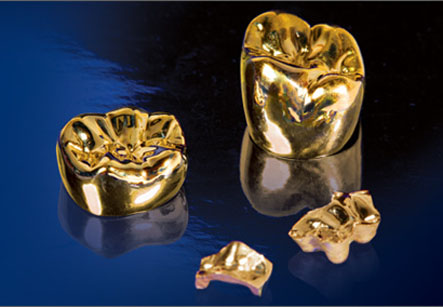Gold Crown
Introduction
A dental crown is a cap placed over a tooth for restoring its shape, size, strength and also for improving its appearance. These crowns totally enclose the visible part of the tooth lying above the gum line after cementing.
A dental crown is needed in the following conditions:
1. For protecting a week tooth from decay, from breaking or for holding parts of a cracked tooth.
2. For restoring broken or severely worn out tooth.
3. For supporting and covering a tooth with large filling.
Iran offers a superior Dental treatments that is world best quality. For patients from the USA, and Europe for example, the savings can be 60% or more

4. For holding a permanent dental bridge between abutment teeth.
5. For covering a dental implant
There are many different types of crowns used in modern dentistry for restoration of tooth. One of the important types of crown is gold crown which is being used in dentistry for a number of years.
There are two main types of gold crowns used to restore a tooth. One is made entirely from gold or gold alloy and is called as full gold crown. Other type is made from a combination of gold and porcelain and is known as porcelain fused to metal (PFM) crown. There are three types of alloy used for fabricating gold crowns. These are as follows:
1. High Noble Alloy- it is a Precious metal type made from about 60% high noble alloy. This is a combination of gold, platinum and palladium. If combination of these alloys is used, at least 40% of it should be of gold.
2. Noble Alloy- this is a Semi Precious metal type which consists of 25% precious metal.
3. Non-Noble Alloy- this is a Non-Precious metal type made from less than 25% precious metals. Noble alloy is usually made from a combination of nickel, chromium, and gold.
Properties of Gold Crowns:
1. Gold crowns have ability to withstand heavy stresses from chewing forces. These crowns usually do not chip or break; therefore they are long lasting dental restorations.
2. A tooth restored with a gold crown usually breaks only if the underlying tooth structure has fractured or decayed.
3. Eating sticky foods and candy can make the gold crowns loose, as is the case with all types of crowns and bridges.
4. Gold crowns cause minimal wear on the opposing tooth. For patients who have habit of grinding their teeth or having a heavy bite, a gold crown usually causes the same amount of wear on the teeth as caused by the tooth’s natural enamel.
5. The gold crowns are used in restoration of back teeth such as molars and premolars because of their classic yellow or white gold color. One more reason for using it for back teeth is that there is more biting stress on these teeth which can be tolerated by gold crowns.
6. Sometimes the patients request placing gold crowns for the front teeth as a fashion statement.
Suitability for a Gold Crown:
Gold crowns are excellent option for those patients who are not concerned about cosmetic purpose or white smile.
Selection of a gold crown for is by far a personal choice. The dentist may recommend a gold crown in case if the patient exhibits heavy wear patterns on the teeth. People having metal allergies should inform the dentist about this fact before a gold crown is fabricated. An example of this is nickel allergy. Non-noble alloy that contains nickel or other common metals causing allergic reactions should be carefully used in such cases.
Cost effectiveness:
As gold is a very expensive metal, certainly the gold crowns cost more than standard porcelain or other crowns. This making charge in the laboratory includes this cost. Thus, it is less cost-effective but efficient restoration.
Advantages:
1. Gold crowns are excellent option for those patients who are not concerned about cosmetic purpose or white smile.
2. Longevity of this restoration is excellent.
3. Attractive look in patients.